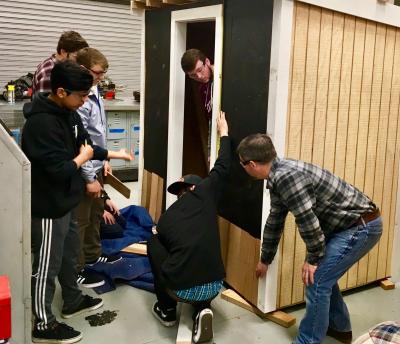High School Builds a Conduit to Trades

The New York State Board of Education asks schools to ensure that students are “college and career ready,” said Christina DeSanti, the vice president of East Hampton’s school board, adding that the district “has done a fine job on the college ready side of the equation, and now we are beginning to focus on the career-ready part.”
The school board announced during its meeting last week that it will increase the budget for vocational education at the high school in an attempt to revamp the department by offering more relevant classes as well as modernizing existing ones. The goal is to help fill the growing demands of service industries with trained young professionals.
Richard Burns, the district superintendent, informed those at the meeting that following discussions with the owners of Grant’s Heating and Cooling and Schenck Fuels, East Hampton companies, the high school will add $9,500 to the technology and manufacturing department to offer a first level safety course in heating, ventilation, and airconditioning, as well as a preliminary HVAC class. Upon completion of these semester-long courses, students will be able to take a certification exam on-site. The two local companies have agreed to offer certified students internships with possible offers of employment after graduation.
An additional $5,000 also will be budgeted for the family and consumer science department, which will offer 10th, 11th, and 12th graders the opportunity to obtain a food handler’s certificate for summer jobs in the restaurant and catering businesses. The school will also develop a baking club to be run in conjunction with the business department, with the idea of potentially selling what it bakes.
East Hampton High School, like almost any other around the country, has offered technical courses over the years — known traditionally as “shop” — designed to provide students with introductory skills in carpentry, automotive repair, and more recently coding, robotics, and drone technology. Students with a more serious desire to pursue careers in those trades have an option to enroll in two-year programs at the Suffolk County Board of Cooperative Educational Services centers in Riverhead, Mastic, and Bellport.
“Those kids were spending up to an hour and a half each way traveling there and back,” Mr. Burns said, which often meant students not only missed out on school work but also the chance to take part in school life and activities. “They very often gave up on the courses because it was just too time-consuming.”
Vocational training in schools around the country has largely been overshadowed by a concerted push to send more kids to college. This nationwide trend took root after the deep recession in 2008 led to a downsizing of American manufacturing, which bulldozed plans for many young people for whom a career in trade jobs was preferred. Many of those youngsters were then forced to ontemplate a new path: college.
East Hampton High School is no exception. Since 2008, Karen Kuneth, the school’s college coordinator, said the rate of graduating seniors planning to attend four-year or two-year colleges has risen. Last year’s graduating class saw 85 percent commit to higher education, up from 74 percent from 2008.
“But college is not for everyone,” Mr. Burns said, adding that he regularly sees students go to college simply because it is the prescribed route and soon realize it’s not for them and drop out. “So, it is just as important to provide opportunities to all our students, whether they want to go to college or join the workforce.”
Additionally, Ms. DeSanti said, “We live in a resort community where most of the full-time jobs are in the food and hospitality business, real estate, and service trades.” Local business owners in these industries, she said, all say they have jobs to offer but few skilled workers to fill them. “Many of these companies offer good salaries and benefits,” she continued, “but they simply cannot find skilled employees. So, we’re beginning to focus on bringing back vocational ed programs as our next academic initiative.”
A report in The New York Times last year stated that while employment among recent college graduates has shown signs of recovery, the more revealing number is that 43.5 percent of college graduates ages 22 to 27 were employed in “non-college,” or service-related jobs, compared with 41.8 percent in 2007.
Many colleges and universities have responded to the need to prepare students for skilled jobs. The State University at Farmingdale in Nassau County recently introduced a natural-gas technician certificate program in partnership with National Grid, an energy provider, with an alluring promise appearing under the course description on the school’s website: “How would you like to take a 12-week, 90-hour training program and be hired practically the minute after you’ve been handed your certificate?”
In East Hampton, the school board plans to look into offering certification for early childhood education with the hope that such training would result in job opportunities for high school students and keep them in the area, Ms. DeSanti said.
How far the school’s in-house vocational education will expand also depends on East Hampton’s voters. A bond referendum for the purchase of town-owned property on Springs-Fireplace Road, which is to become the school district bus depot and a vocational training center, will be on the ballot on May 15.
“Should the voters approve the construction of the new bus barn facility, designed to include classrooms for student vocational program learning,” Ms. DeSanti said, “it will even allow us to offer programs such as boat and small engine repair, welding, and automotive repair, which are now only offered by BOCES in UpIsland locations. Of course, even if the bond is approved, these programs would not be in place until construction is completed, so they are longer range plans,” she said.
